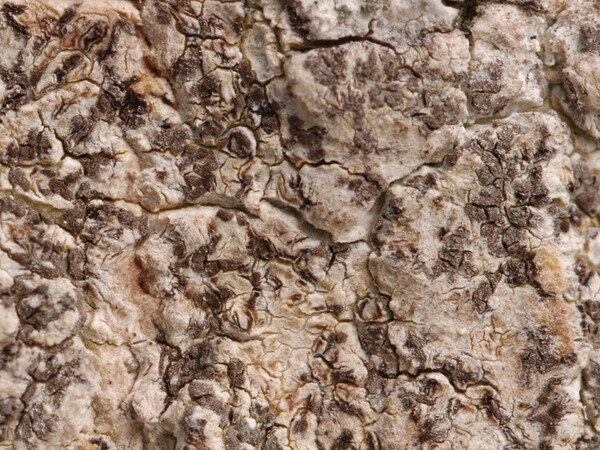Reichlingia zwackhii (Sandst.) Frisch & G. Thor
in Frisch & al., Nova Hedwigia, 98: 310, 2014. Basionym: Arthonia zwackhii Sandst. - Abh. naturw. Ver. Bremen, 17: 604, 1903.
Synonyms:
Distribution: C - Tosc, Laz.
Description: Thallus crustose, up to 80 μm thick, effuse, white to pale grey, matt, continuous to slightly rimose. Apothecia arthonioid, of very different shapes, from rounded to linear-lirelliform, scattered to crowded into irregularly stellate groups, up to 0.7 mm across, in section 65-95 μm tall, red-brown, but often thinly white-pruinose, without a proper margin. Proper exciple poorly developed, dark brown, of paraphysoid-like hyphae; epithecium red-brown, K+ pale green; hymenium colourless or pale reddish brown in upper part, 40-50 μm high, hemiamyloid; paraphysoids branched and anastomosing, 1-2(-3) μm thick, the apical cells brown-walled and to 4-6 μm wide, a few with a brown cap; hypothecium pale to dark brown, 15-40 μm high, Asci (6-)8-spored, clavate, semi-fissitunicate, with a large apical dome and a distinct ocular chamber, without K/I+ tholus structures. Ascospores 3-4(-5)-septate, the apical cell enlarged, hyaline but turning brown and warted when overmature, cylindrical-obovoid to slightly clavate, 16-23(-26) x 5-7 μm. Photobiont trentepohlioid. Spot tests: thallus K-, C-, KC-, P-, or P+ patchily yellow, UV-. Chemistry: thallus with an unidentified substance and 2'-O-methylperlatolic acid. Note: a mild-temperate to tropical species found on smooth bark, especially of Fraxinus and Carpinus, in humid deciduous woodlands, often associated with Phlyctis argena; in Italy it was overlooked or confused with other species, and is perhaps more widespread, but never common, being included in the Italian red list of epiphytic lichens as “Endangered” (Nascimbene & al. 2013c).
Growth form: Crustose
Substrata: bark
Photobiont: Trentepohlia
Reproductive strategy: mainly sexual
Most common in areas with a humid-warm climate (e.g. most of Tyrrenian Italy)
Commonnes-rarity: (info)
Alpine belt: absent
Subalpine belt: absent
Oromediterranean belt: absent
Montane belt: extremely rare
Submediterranean belt: absent
Padanian area: absent
Humid submediterranean belt: very rare
Humid mediterranean belt: absent
Dry mediterranean belt: absent

Predictive model
Herbarium samples
Growth form: Crustose
Substrata: bark
Photobiont: Trentepohlia
Reproductive strategy: mainly sexual
Most common in areas with a humid-warm climate (e.g. most of Tyrrenian Italy)
Commonnes-rarity: (info)
Alpine belt: absent
Subalpine belt: absent
Oromediterranean belt: absent
Montane belt: extremely rare
Submediterranean belt: absent
Padanian area: absent
Humid submediterranean belt: very rare
Humid mediterranean belt: absent
Dry mediterranean belt: absent

Predictive model
| Herbarium samples |
 INDEX FUNGORUM
INDEX FUNGORUM
 GBIF
GBIF




